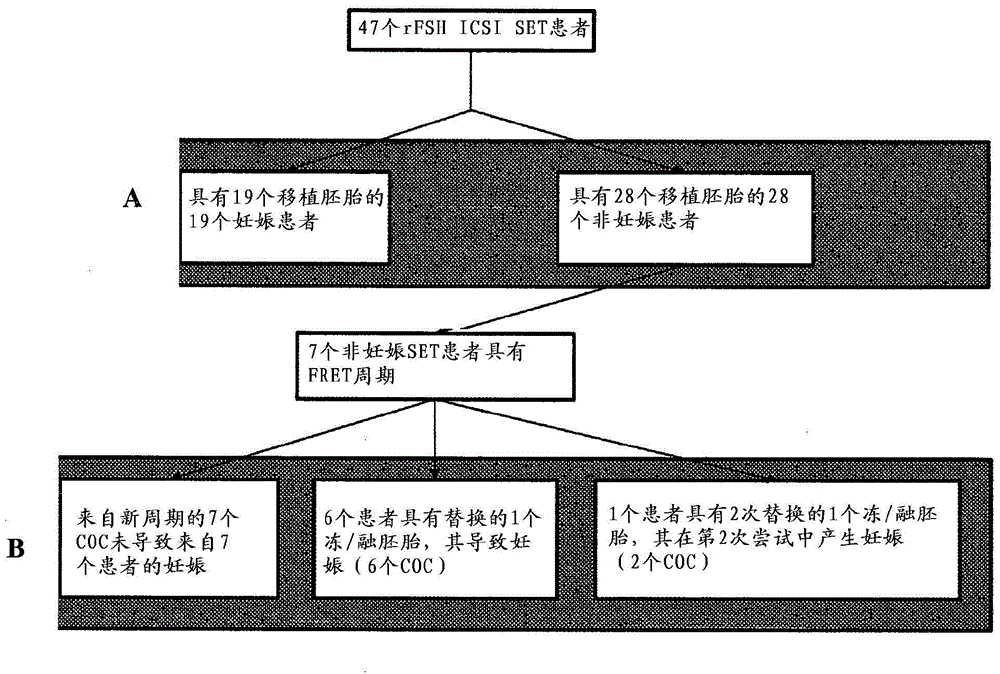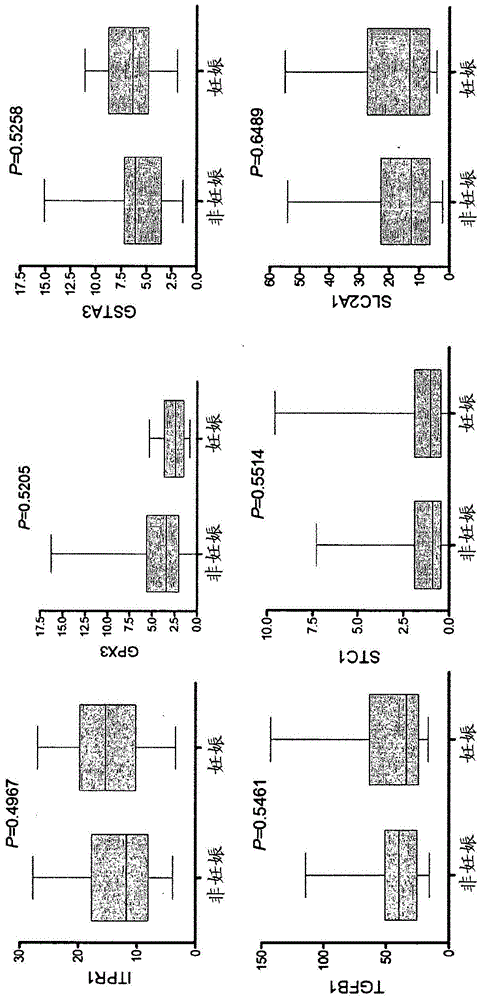Marker genes for oocyte competence
A technology of oocytes and cumulus cells, which is applied in the field of end-point standards of oocytes, and can solve problems such as undiscovered genes
- Summary
- Abstract
- Description
- Claims
- Application Information
AI Technical Summary
Problems solved by technology
Method used
Image
Examples
Embodiment 1-Q
[0166] Embodiment 1-QPCR analysis
[0167] Materials and Methods
[0168] Patient group
[0169] This study was approved by the UZBrussel Ethics Committee and written consent was obtained from the patients. Forty-seven ICSI patients were selected based on the embryo transfer policy (single embryo transfer), and an ovulation induction protocol was formulated: GnRH antagonist (Gonal-f, Merck-Serono, Geneva, Switzerland; n=4 or Puregon, MSD, Oss, Netherlands; n=43). Causes of infertility were: male factor only (n=19), female factor only (ovulation disorder n=3, and tubal infertility n=2), combined male and female factor (OAT and endometriosis n =3) and idiopathic (n=20). Twenty patients had single embryo transfers at culture day 3, of which 10 became pregnant. Twenty-seven patients had transplants at day 5, of which 9 became pregnant.
[0170] Collection of human cumulus cells and culture of embryos
[0171] Vaginal ultrasound is used to monitor follicular development. Th...
Embodiment 2
[0238] Example 2 - Exon level analysis
[0239] Three microarray experiments were performed and the resulting data resulted in 4 microarray analyses. Designated below as Microarray Analysis 1, 2, 3 or 4, respectively (see Table 14 below). Array experiments 1 and 2 were used for data mining (to find genes or exons of genes that were predictive for oocyte competence), and array experiment 3 was used to filter frequently occurring predictive genes (to find genes that could be applied more generally or exons, as they were predictive in different fertility centers and after slightly different treatments). The most recent analysis is based on a microarray experiment 2 that includes intra-patient and intra-cycle (oocytes from the same stimulated cohort) analysis for live births.
[0240] Material:
[0241] For the three microarray experiments, cumulus cells were collected as previously described (Wathlet et al. 2011). RNA was extracted using the Qiagen Rneasymicro kit as descri...
Embodiment 3
[0275] Example 3 - Retrospective Study
[0276] A retrospective study was performed with samples collected from 107 patients in two clinical settings. QPCR for 7 oocyte quality markers (HSPH1 exon 2, HSPH1 exon 6, CAMK1D exon 1, CAMK1D exon 9, EFNB2, NCOA7, Exon execution specific to SASH1) and 2 endogenous controls (UBC and B2M) (Table 9).
[0277] Table 9: Samples available for proof-of-concept studies. B1 / 2 / 3 = Batch 1 / 2 / 3, Site 1+2 = European and US Fertility Centers, Patient Pretreatment = GnRH antagonist in combination with rFSH or HP-hMG, and Pregnancy Outcome = At least 2 pregnancies post-transplant weeks, non-pregnant = no pregnancy after transfer, delayed = embryos developed slowly and not considered for transfer
[0278]
[0279] Cumulus cell collection:
[0280] Cumulus cell samples were collected at one European and one US fertility center (Table 9) and were derived from patients who had obtained one embryo / transfer (SET = single embryo transfer) and de...
PUM
 Login to View More
Login to View More Abstract
Description
Claims
Application Information
 Login to View More
Login to View More - R&D
- Intellectual Property
- Life Sciences
- Materials
- Tech Scout
- Unparalleled Data Quality
- Higher Quality Content
- 60% Fewer Hallucinations
Browse by: Latest US Patents, China's latest patents, Technical Efficacy Thesaurus, Application Domain, Technology Topic, Popular Technical Reports.
© 2025 PatSnap. All rights reserved.Legal|Privacy policy|Modern Slavery Act Transparency Statement|Sitemap|About US| Contact US: help@patsnap.com



